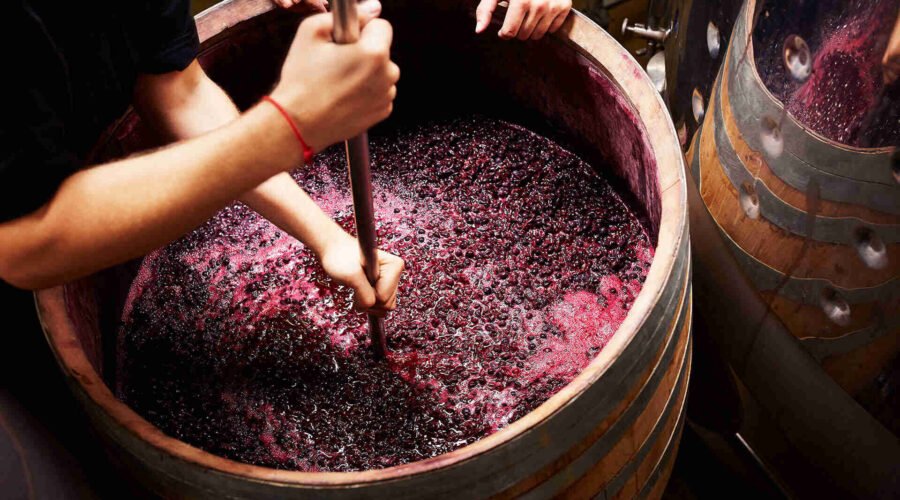Alcoholic Fermentation: What Is It, and Why Is It Important?
If you’ve ever enjoyed a glass of Chardonnay or Champagne, it’s time to raise a glass to the chemical process known as alcoholic fermentation. Without it, your favorite wine couldn’t give you a little buzz. You’d just be drinking grape juice.
But how does it happen? We talked to some of our favorite winemakers, cider brewers and sommeliers to get all the details on alcoholic fermentation. But don’t get it twisted: The stars of this story are yeast and sugar, since there would be no alcohol without either. Here’s everything you need to know about it.
What Is Alcoholic Fermentation?
Alcoholic fermentation is the chemical process that creates alcohol. Basically, it comes down to yeast eating a form of sugar, which is the starting point for everything from beer and wine to sake and cider. Even hard liquors—like your favorite tequila, perhaps—start with simple alcoholic fermentation. It then goes through another process called distillation to become a spirit, but that’s a whole other story.
What Is Yeast?
As Karen MacNeil explains in her authoritative tome The Wine Bible, now out in its third edition, yeast is a tiny, single-cell organism.
There are hundreds of strains of commercial yeast, and anyone making beer, wine or cider is very particular about the ones they use. Different commercial yeasts can produce different flavors. For example, if you wanted to make a hard apple cider with notes of apple blossom and dried hay, you might choose a yeast strain known for creating those flavors.
How Does Yeast Cause Alcoholic Fermentation?
As yeast converts sugar into alcohol, it also creates carbon dioxide and heat, which raises the temperature of the fermenting grapes from 60° to 85° Fahrenheit. The yeast will keep eating the sugar until it’s all gone, or until the level of alcohol in the mixture reaches about 16%. Above that level, the alcohol will kill the yeast and stop it from converting any more sugars.
Many growers pick their grapes at night or early in the morning to prevent the fruit from getting so hot that it begins to ferment on its own. This is also why it’s usually recommended to store beers, wines and ciders in cool, dry places away from sunlight. If a bottle gets hot, there’s always a chance that the yeast inside will heat up and start eating the sugars within, thus bumping up the ABV of the bottle and potentially altering its flavor. It could also make the bottles burst, which for obvious reasons isn’t great.
However, with naturally-fermented wines and ciders, no commercial yeast is added. That’s because natural yeast strains are all around us—in the air, on the outside of grapes and apples and inside a winery or cidery. Natural wine and cider makers press their fruit and then let the natural, ambient yeasts that are floating around get busy.
Where Does the Sugar Used in Fermentation Come From?
Grape juice and apple juice are noticeably sweet, but even rice and grains have sugary starches in them that yeast can convert to alcohol. Grains for beer are simmered in water to release the sugars first, which creates a starchy liquid called the wort.
What Are the Byproducts of Alcoholic Fermentation?
There are three main byproducts of alcoholic fermentation. Unsurprising, a significant one is alcohol, which has historically been a key attribute of beer, wine and hard cider. (For what it’s worth, however, there are plenty notable zero-ABV drinks on the scene these days.)
But there are other byproducts, too. “When sugars are fermenting into alcohol it produces a lot of heat,” says Ashley Trout, winemaker and owner of Vital Wines and Bull & Brook Cellars in Walla Walla, Washington. Five-tons of fermenting grapes, for instance, produces quite a bit of heat. As mentioned earlier, the yeast can get so hot, they die—which can burn off all the beautiful aromas in the wine.
The last major byproduct of fermentation is carbon dioxide. If you get a chance to go to a winery and witness the fermentation phase of production, you’ll notice that the fermenting juice is a little bubbly. This is thanks to the release of carbon dioxide, which is also what gives Champagne and sparkling wines their effervescence. The highest-quality sparkling wines see a secondary fermentation inside the bottle, which further traps carbon dioxide bubbles.
Flavor is in large part determined by what happens during fermentation. “You may get more orchard fruit notes, which you’ll see in Chardonnay and Sauvignon Blanc as well,” says Tonya Pitts, sommelier and wine director at One Market in San Francisco. “In Champagne, you would probably get …more of … that kind of brioche, fresh baked bread, creamy butteriness.”
What’s the Chemical Equation for Alcoholic Fermentation?
If you want to get wonky, here’s the chemical equation for fermentation:
C6H12O6 → 2C2H5OH + 2CO2
For all you non-science-minded folk, this formula essentially describes what happens when a yeast cell eats a sugar molecule, thus converting it into alcohol and carbon dioxide.
If it’s not yet abundantly clear, alcoholic fermentation is deeply important to the drinks we know and love. Without it, there’d be no ripe Pinot Noirs, no crisp Rieslings, no flinty Sauvignon Blancs. No hoppy IPAs or smoky mezcals. Not even a funky kombucha.
It’s just another example of how science shapes the way we eat and drink. Want to learn more? There’s plenty more to discover, from the science behind beer flavors to molecular engineering in spirits.




